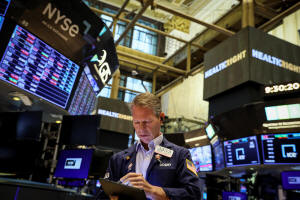Marketmind: Hard Labor
 Send a link to a friend
Send a link to a friend
 [September 02, 2022] A
look at the day ahead in U.S. and global markets from Mike Dolan. [September 02, 2022] A
look at the day ahead in U.S. and global markets from Mike Dolan.
As Americans prepare for the long Labor Day weekend, the U.S. labour
market appears tight as a drum.
At just 3.5%, the joint lowest jobless rate since the 1960s should be
cause for celebration and sooth fears of imminent recession. But
financial markets have been on edge all week that such a strong jobs
market will just spur wage rises to better match decades-high inflation
and force the Federal Reserve to step harder on the interest rate brake
to slow the whole train down.
Along with the next consumer inflation report, Friday's release of the
August jobs tally is one of two key data that will define this month's
Fed policy decision. Markets already assume a 75% chance of a third 75
basis point rate rise in a row, with expectations for the Fed's
'terminal rate' early next year back at 4% for the first time since
midyear.
Economists expect the pace of monthly job growth to slow to a still
robust 300,000 from over 500,000 in July, but the unemployment rate
should hold at a historically low 3.5%.

After a torrid week in bonds and stocks ahead of the data, there's been
some position squaring over the past 24 hours. U.S. stock futures are
flat on Friday, even though two-year Treasury yields continued to creep
higher and topped 3.55% for the first time in 15 years.
Bank of America's fund monitor showed the fourth biggest weekly exit
from equity funds of the year.
Even though the dollar's relentless rise saw it hit 140 Japanese yen for
the first time in 24 years, its broader DXY index pulled back slightly
from Thursday's new 20-year peak. The euro popped back toward parity,
with a 75 basis point European Central Bank rate rise next week almost
fully priced in, and sterling clawed its way above $1.15 after its
latest lunge to post-pandemic lows.
But while labour market tightness was the issue of the day, there were
more signs of an easing of commodity-price pressures that have been
aggravating inflation since the Russian invasion of Ukraine in late
February.
[to top of second column] |

A trader works on the floor of the New
York Stock Exchange (NYSE) in New York City, U.S., August 29, 2022.
REUTERS/Brendan McDermid

G7 finance ministers hold a virtual meeting on Friday to agree a cap on Russian
crude oil prices.
China's latest sweeping lockdowns to contain COVID also undermined demand.
And while nominal two-year bond yields climb, 2-year U.S. inflation expectations
derived from the inflation-protected bond markets have fallen below 2.5% for the
first time since February 2021.
Even though Brent crude oil prices were a touch higher on Friday, the
year-on-year rise in crude critical to headline inflation watchers fell below
30% for the first time since March 2021.
What's more, the United Nations food agency said its world price index fell for
a fifth month in a row in August. Although still almost 8% higher than a year
ago, it has now retreated 15% from the March peak. World shipping prices, down
60% since May, fell to post-pandemic lows this week too.
In banking, Credit Suisse is considering cutting around 5,000 jobs, about one
position in 10, as part of a cost reduction drive at Switzerland's
second-biggest bank, a source with direct knowledge of the matter told Reuters.
Key developments that should provide more direction to U.S. markets later on
Friday:
* U.S. August employment report, July factory goods orders
* G7 finance ministers and central bank governors hold virtual meeting
(By Mike Dolan, editing by XXX mike.dolan@thomsonreuters.com. Twitter: @reutersMikeD;
Editing by Tomasz Janowski)
[© 2022 Thomson Reuters. All rights
reserved.]This material may not be published,
broadcast, rewritten or redistributed.
Thompson Reuters is solely responsible for this content.
 |